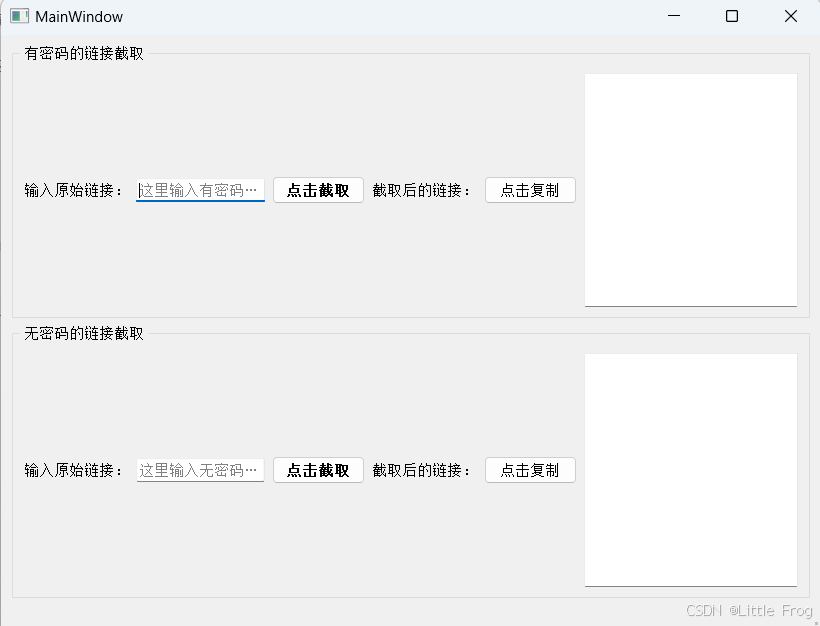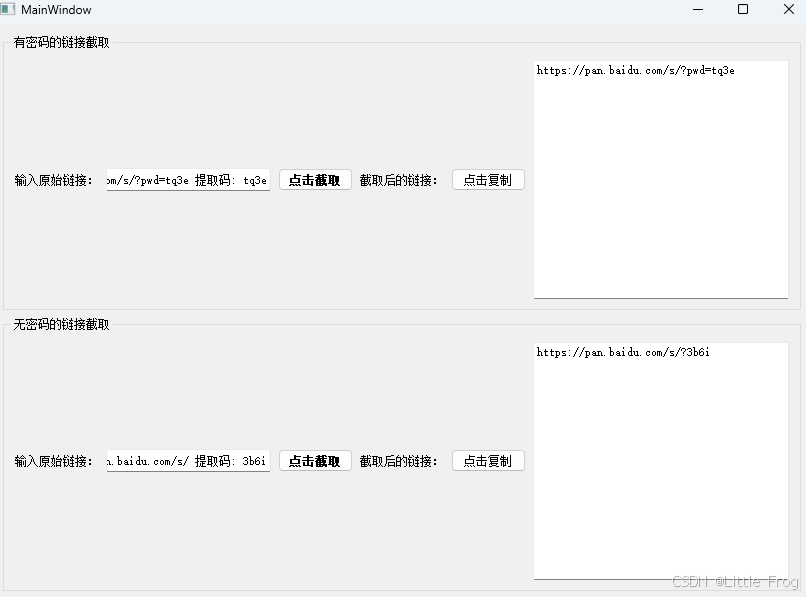一个有一点点作用的小工具。每次获取到资源的时候 一般格式为:
XXXX+链接+https链接 + 提取码:xxxx。
或者
XXXX+链接+https链接?pwd + 提取码:xxxx
例如:
1.链接:https://pan.baidu.com 提取码:33om
2.链接: https://pan.baidu.com?pwd=p73q 提取码: p73q
每次复制粘贴到浏览器的时候,感觉操作很繁琐,特别是第一种情况,还需要手动输出密码。
如此就想写一个工具,去除链接中其他的文件信息,提取出整个链接,并且将第一种也变为第二种的格式。
ui设计由pyqt5实现:

界面如上图所示。
有密码的链接意为:链接中带有?xxxx。
执行示例:
链接1:链接 https://pan.baidu.com/s/?pwd=tq3e 提取码: tq3e
链接2:链接https://pan.baidu.com/s/ 提取码: 3b6i

点击复制,也能将链接复制到剪切板上。
py文件的代码为:
其中使用到了正则表达式进行匹配。
import os
from PyQt5.QtWidgets import *
from PyQt5 import uic, QtWidgets
import sys
import re
def processPath(path):
'''
:param path: 相对于根目录的路径
:return: 拼接好的路径
'''
if getattr(sys, 'frozen', False): # 判断是否存在属性frozen,以此判断是打包的程序还是源代码。false为默认值,即没有frozen属性时返回false
base_path = sys._MEIPASS # 该属性也是打包程序才会有,源代码尝试获取该属性会报错
else:
base_path = os.path.abspath(".") # 当源代码运行时使用该路径
return os.path.join(base_path, path)
class MyWindows(QWidget):
def __init__(self):
super().__init__()
self.ui = uic.loadUi(processPath('baidu_link.ui'))
# 增加底层文字
self.ui.re_link1.setPlaceholderText('这里输入有密码的链接')
self.ui.re_link2.setPlaceholderText('这里输入无密码的链接')
# 设置采集模块为只读模式
self.ui.link_res1_2.setReadOnly(True)
self.ui.link_res2.setReadOnly(True)
# 信号绑定
self.ui.bt1.clicked.connect(lambda: self.fun_one(self.ui.re_link1))
self.ui.bt2.clicked.connect(lambda: self.fun_two(self.ui.re_link2))
self.ui.copy1.clicked.connect(lambda:self.copy_to_clipboard_one())
self.ui.copy2.clicked.connect(lambda:self.copy_to_clipboard_two())
self.ui.show()
def fun_one(self, link_one):
link = link_one.text()
url_pattern = r'https?://[^\s]+'
urls = re.findall(url_pattern, link)
res_link_one = urls[0]
self.ui.link_res1_2.setText(res_link_one)
def copy_to_clipboard_one(self):
# 获取文本并复制到剪切板
text = self.ui.link_res1_2.toPlainText()
print(f"准备获取的文本是: '{text}'") # 输出当前的文本
print(text)
if text:
clipboard = QApplication.clipboard()
clipboard.setText(text)
QMessageBox.information(self, "成功", "文本已复制到剪切板!")
else:
QMessageBox.warning(self, "警告", "文本框为空!")
def fun_two(self, link_two):
link = link_two.text()
url_pattern = r'https?://[^\s]+'
urls = re.findall(url_pattern, link)
pwd = link[-4:]
print(pwd)
res_link_two = urls[0] + "?" + pwd
self.ui.link_res2.setText(res_link_two)
def copy_to_clipboard_two(self):
# 获取文本并复制到剪切板
text = self.ui.link_res2.toPlainText()
if text:
clipboard = QApplication.clipboard()
clipboard.setText(text)
QMessageBox.information(self, "成功", "文本已复制到剪切板!")
else:
QMessageBox.warning(self, "警告", "文本框为空!")
if __name__ == '__main__':
app = QApplication(sys.argv)
myapp = MyWindows()
sys.exit(app.exec_())
ui文件的代码为
<?xml version="1.0" encoding="UTF-8"?>
<ui version="4.0">
<class>link_res1</class>
<widget class="QMainWindow" name="link_res1">
<property name="geometry">
<rect>
<x>0</x>
<y>0</y>
<width>820</width>
<height>600</height>
</rect>
</property>
<property name="windowTitle">
<string>MainWindow</string>
</property>
<widget class="QWidget" name="centralwidget">
<layout class="QGridLayout" name="gridLayout">
<item row="0" column="0">
<widget class="QGroupBox" name="groupBox">
<property name="title">
<string>有密码的链接截取</string>
</property>
<layout class="QHBoxLayout" name="horizontalLayout_2">
<item>
<layout class="QHBoxLayout" name="horizontalLayout">
<item>
<widget class="QLabel" name="label">
<property name="font">
<font>
<weight>50</weight>
<italic>false</italic>
<bold>false</bold>
</font>
</property>
<property name="text">
<string>输入原始链接:</string>
</property>
</widget>
</item>
<item>
<widget class="QLineEdit" name="re_link1"/>
</item>
<item>
<widget class="QPushButton" name="bt1">
<property name="font">
<font>
<weight>75</weight>
<bold>true</bold>
</font>
</property>
<property name="text">
<string>点击截取</string>
</property>
</widget>
</item>
<item>
<widget class="QLabel" name="label_2">
<property name="font">
<font>
<weight>50</weight>
<italic>false</italic>
<bold>false</bold>
</font>
</property>
<property name="text">
<string>截取后的链接:</string>
</property>
</widget>
</item>
<item>
<widget class="QPushButton" name="copy1">
<property name="text">
<string>点击复制</string>
</property>
</widget>
</item>
<item>
<widget class="QTextEdit" name="link_res1_2"/>
</item>
</layout>
</item>
</layout>
</widget>
</item>
<item row="1" column="0">
<widget class="QGroupBox" name="groupBox_2">
<property name="title">
<string>无密码的链接截取</string>
</property>
<layout class="QHBoxLayout" name="horizontalLayout_3">
<item>
<layout class="QHBoxLayout" name="horizontalLayout_4">
<item>
<widget class="QLabel" name="label_3">
<property name="font">
<font>
<weight>50</weight>
<italic>false</italic>
<bold>false</bold>
</font>
</property>
<property name="text">
<string>输入原始链接:</string>
</property>
</widget>
</item>
<item>
<widget class="QLineEdit" name="re_link2"/>
</item>
<item>
<widget class="QPushButton" name="bt2">
<property name="font">
<font>
<weight>75</weight>
<bold>true</bold>
</font>
</property>
<property name="text">
<string>点击截取</string>
</property>
</widget>
</item>
<item>
<widget class="QLabel" name="label_4">
<property name="font">
<font>
<weight>50</weight>
<italic>false</italic>
<bold>false</bold>
</font>
</property>
<property name="text">
<string>截取后的链接:</string>
</property>
</widget>
</item>
<item>
<widget class="QPushButton" name="copy2">
<property name="text">
<string>点击复制</string>
</property>
</widget>
</item>
<item>
<widget class="QTextEdit" name="link_res2"/>
</item>
</layout>
</item>
</layout>
</widget>
</item>
</layout>
</widget>
<widget class="QMenuBar" name="menubar">
<property name="geometry">
<rect>
<x>0</x>
<y>0</y>
<width>820</width>
<height>26</height>
</rect>
</property>
</widget>
<widget class="QStatusBar" name="statusbar"/>
</widget>
<resources/>
<connections/>
</ui>
另外,上一篇博客讲述了如何使用pyinstaller打包这两个文件,有兴趣的可以去试试。




















 1527
1527

 被折叠的 条评论
为什么被折叠?
被折叠的 条评论
为什么被折叠?








